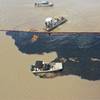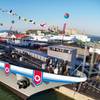Ballistic Net System Stops Small Boats
Moscow Mills Manufacturing and Foster-Miller, Inc. of Waltham, Mass., have announced a new non-lethal system for stopping small boats such as those used by pirates, drug traffickers and terrorists. The companies are working in conjunction with the Pentagon's Joint Non-Lethal Weapons Directorate program in Quantico, Va. and the U.S. Coast Guard to move the project into even more widespread usage.
The system, dubbed "Boat Trap" uses ballistic nets dropped from aircraft to ensnare and stop small boats without using lethal force. The Boat Trap has been extensively tested in both U.S. waters and in the Caribbean. It is currently being deployed on a limited basis by U.S. government agencies.
"The Boat Trap has been designed specifically to stop small boats in crowded areas," said Anderson Leveille, founder of Moscow Mills Manufacturing. "These small, often high-speed craft, whether operated by pirates, terrorists or drug smugglers, are a constant threat. Because these small boats tend to operate close to shore and in populated areas, use of lethal force is often not an option. Using the boat trap's ballistic net technologies, these threats craft can be stopped and the crews captured before they take over a ship or cause a terrorist incident."
The Boat Trap program originated through the Pentagon's Joint Non-Lethal Weapon's Directorate in Quantico, Virginia and has been supported by the U.S. Coast Guard. The JNLWD has the mission to develop non-lethal responses to combat operations, terrorism and related threats such as piracy. Both the US Coast Guard and JNLWD have been leaders in developing capabilities such as the Boat Trap which are vital to protecting against piracy, terrorism, drug smuggling and human trafficking.
The Boat Trap uses a non-lethal ballistic net deployed from a helicopter into the path of a threatening boat. The net-based system ensnares the propellers of a target speedboat, disabling the craft, preventing forward progress. The nets, which are opened by weights propelled from central charge blocks, foul the propellers, rudders and steering gear of boats, stopping them at a safe distance from potential targets.
By using the Boat Trap, defense and law-enforcement personnel will have another option that can help avoid the need to use guns or other lethal weapons in crowded harbors where stray bullets pose a threat to bystanders and non-combatants. In areas such as the Gulf of Aden where it is easy to mistake pirates for innocent fishermen or merchant traffic, the Boat Trap provides another option for securing ships.
The Boat Trap was developed in response to the attack on the USS Cole, in Yemen and is applicable anywhere small craft pose a threat or need to be stopped for interdiction purposes such as drug smuggling, piracy or human trafficking.
The current version is designed for deployment from helicopters, but new versions are in development that can be launched directly from ships or from harbor installations. The boat trap uses proprietary ballistic net technology developed by QinetiQ's Foster Miller unit in Waltham, Mass.
(www.moscow-mills.com)








